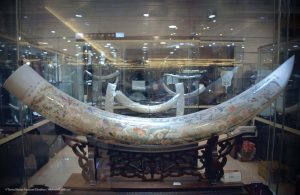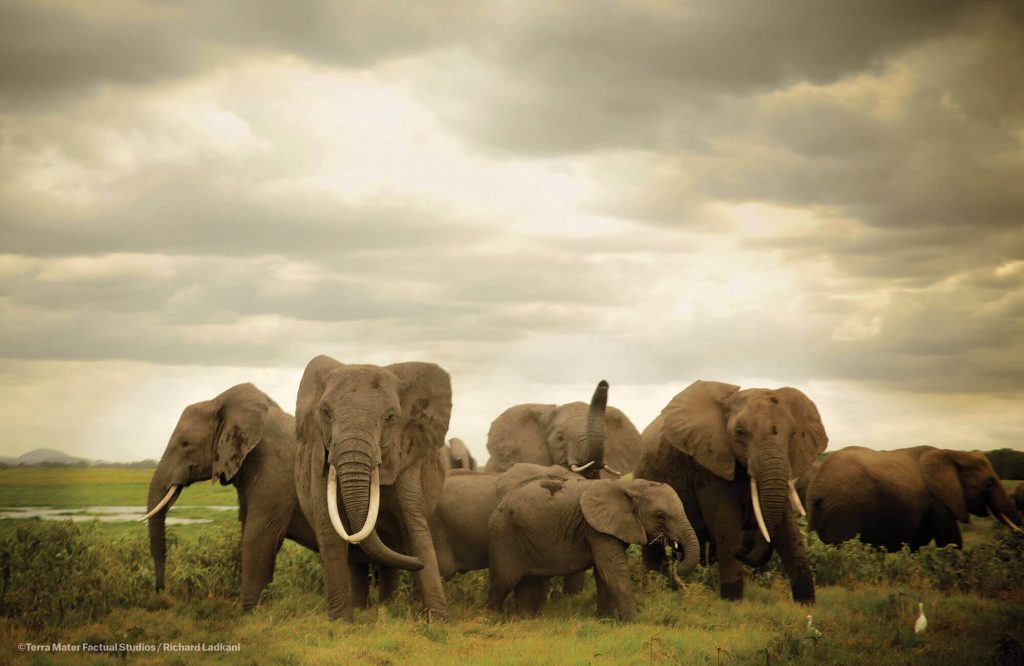On December 29, 2016, after years of pressure from advocacy groups and individuals around the world, China announced it would completely ban its ivory market by the end of 2017. Conservationists hailed the historic decision as a “game changer” for African elephants, whose populations have been dwindling toward extinction at the hands of poachers. These killings are largely fueled by the demand from illegal ivory markets, particularly in China and the U.S., where the appetite for luxury ivory items has increased.

Decorated ivory tusk. Photo courtesy of theivorygame.com
The announcement follows less than two months after the global premiere of Netflix’s new documentary, “The Ivory Game,” which interweaves the stories of wildlife activists and investigators battling poachers in Africa and exposing dealers in China. The Oscar-shortlisted documentary makes its call to action abundantly clear: The world’s largest ivory market, China, holds the key to the “species fate.”
Even some of the film’s final text highlights the pressing need for a total ban, reading, “China has not yet provided any timetable …. The fight continues…”
Of course, now we know that the timetable for the ban is this year.
At first glance, it could seem as though this new, issue-focused documentary prompted one of the world’s superpowers to make a groundbreaking policy change. Upon hearing the news, conservation icon Jane Goodall wrote that the filmmakers “are to be congratulated” for the influence of their film, but most legacy media outlets like The New York Times have made no mention of the documentary in reference to the decision.
What role did “The Ivory Game” play?
Like any experiment in the field, fully disentangling the effects of a film from a myriad of socio-political factors is virtually impossible. However, the Center for Media and Social Impact’s 2014 report, Assessing the Social Impact of Issue-Focused Documentaries, demonstrates how issue-focused documentaries can embed themselves in advocacy movements to generate social change. A prime example is “Blackfish,” a 2013 documentary that fueled impact over a three-year time period and may have ultimately led to the end of Seaworld’s orca breeding program.
Although both “The Ivory Game” and “Blackfish” can be classified as “eco-documentaries” that evoke empathy for charismatic megafauna (we love our elephants and our orcas!), these documentaries entered the lifecycles of their respective issues at different stages. While “Blackfish” launched a new narrative into the public consciousness, “The Ivory Game” amplified an existing narrative and known policy solution for the ivory trade. In other words, “The Ivory Game” premiered on the tail-end of its issue lifecycle – right at the tipping point of policy change.
Therefore, assessing the potential role of the “The Ivory Game” requires an examination of the building wave of elephant activism, awareness and political pressure leading up to China’s decision. Such insight can reveal how this documentary strategically positioned itself on the verge of an extraordinary political shift.

Photo courtesy of theivorygame.com
1) NGO Activism
Non-governmental organizations (NGOs) were the first to unveil the connection between declining elephant populations and flourishing illegal markets despite the 1989 international ban imposed by CITES (the Convention on International Trade in Endangered Species of Wild Fauna and Flora). In response, organizations began pouring millions of dollars into on-the-ground efforts and publicity campaigns to conserve the species. For example, WildAid launched a three-year campaign in 2013 featuring global PSAs with Yao Ming and numerous other celebrities “saying no to ivory.”
“The Ivory Game” filmmakers capitalized on the expertise of advocacy groups by collaborating with Paul Allen’s Vulcan Productions and Leonardo DiCaprio’s Appian Way as well as a variety of outreach partners like WildLeaks and the Wildlife Justice Commission. All of these partnering organizations are deeply involved in elephant conservation, which enabled them to immediately propel the film through their digital and social networks.
2) A Defined Media Narrative
As NGO presence grew, a variety of media outlets began publicizing the narrative of corruption. In addition to mainstream news sources, entertainment sources like National Geographic chronicled the ivory trade, dedicating a magazine and an episode of Explorer to the issue. Celebrities like Academy-award winner Kathryn Bigelow and actress Kristin Davis amplified awareness by exposing elephant poaching through their own films. Meanwhile, a range of stars from Susan Sarandon to Tommy Hilfinger to Prince William voiced their condemnation of ivory consumption.
In short, the narrative that “human greed will likely lead to elephant extinction” was nothing new by the time “The Ivory Game” hit the screen. The film took advantage of the growing media attention to elephant poaching by promising an exciting, undercover-camera view into the trade’s underworld. It is the same type of high-risk, suspenseful storytelling utilized by 2009’s “The Cove” that attracted wider audiences beyond existing animal advocates.
3) Mounting Political Pressure
Not surprisingly, China faced significant external and internal political pressure in the years leading up to its decision. Though the superpower had long denied its problem, in September 2015, Chinese President Xi Jinping and President Obama agreed to ban the ivory trade in both of their countries. The U.S. (believed to be the world’s 2nd largest market) acted first by strengthening protections in July 2016, thus, putting the ball in China’s court. However, until the announcement on December 29, the country showed no signs of acting on its promise. Analysts also believe that cracking down on ivory may have dovetailed with China’s recent internal campaigns to tackle government corruption and to promote environmental sustainability.
Sensing a turning tide, “The Ivory Game” tailored its distribution to magnify the increasing pressure on China. The filmmakers opted out of more theatrical releases for a swift Netflix release on November 4 in order to reach millions of people in over 190 countries. Although the streaming service is not available in China, Goodall writes that she knows “as a fact” that a few key Chinese government officials had the opportunity to see the film.
The Verdict
Regardless of the precise role of the documentary and associated advocacy on Chinese officials, it can be deemed as a win for its tactical placement within the burgeoning movement to save African elephants. With the problem already well understood, “The Ivory Game,” skillfully leveraged partnerships, enticing storytelling and global distribution to reinvigorate activists and ignite new audiences to urge for this historic decision.
